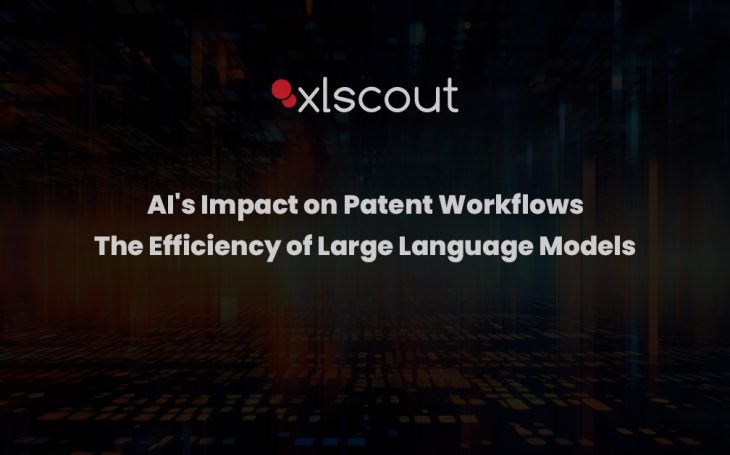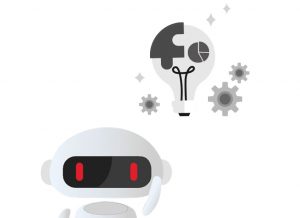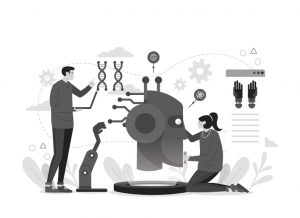
In today’s rapidly evolving technological landscape, Artificial Intelligence (AI) is redefining traditional industries, introducing transformative changes that enhance productivity, accuracy, and innovation. Central to this revolution is the emergence of Large Language Models (LLMs), sophisticated AI architectures that are drastically altering the way patent workflows operate. From the seedling stage of ideation to the intricate processes of drafting and patent monetization, LLMs are unlocking unprecedented levels of efficiency and insight. As we delve into this exploration, we’ll unearth how these groundbreaking models, coupled with platforms like XLSCOUT, are shaping the future of Intellectual Property (IP), fostering a new era where human expertise and machine intelligence harmoniously converge.
The AI Revolution in Intellectual Property (IP)
Understanding the Landscape: Why AI Matters in Patent Workflows
The intellectual property (IP) domain, traditionally characterized by meticulous research, vast amounts of data analysis, and precise legal interpretations, has always been a prime candidate for technological innovation. And with the advent of Artificial Intelligence (AI), this domain is experiencing a renaissance.
At its core, AI embodies the ability to process, analyze, and interpret large volumes of data at speeds incomprehensible to humans. In the context of IP, this capability translates to several transformative advantages. First, patent searches, which once took days or even weeks of exhaustive manual research, can now be streamlined into hours or minutes. AI algorithms, with their pattern recognition capabilities, can sift through global patent databases, extracting relevant results with heightened accuracy.
Beyond mere data retrieval, AI brings a higher order of analytical capability to the table. It can identify trends, forecast the potential of certain patents, and even predict possible infringement scenarios. These insights are invaluable for patent holders, legal teams, and businesses alike, providing a strategic edge in navigating the complex terrain of IP rights and regulations.
Drafting patent applications—a nuanced and intricate process—has also witnessed AI-induced enhancements. By analyzing thousands of successful patent applications, AI tools can provide recommendations, pinpoint potential weaknesses in the draft, or even predict its likelihood of approval. This not only accelerates the patent application process but also increases its chances of success.
Moreover, the integration of AI into IP has led to the development of platforms like Ideacue, Drafting LLM, and ClaimChart LLM. These platforms exemplify the blend of human expertise and AI precision, ensuring that the ideation, drafting, and monetization stages of patent workflows are optimized to the fullest.
In essence, the incorporation of AI into the IP sphere isn’t just a fleeting trend—it’s a seismic shift, redefining how we approach, manage, and leverage intellectual assets. As the IP landscape continues to grow in complexity and scale, the role of AI will only become more pivotal, ushering in a new era of efficiency, accuracy, and innovation.
Deep Dive into Large Language Models (LLMs)
The Science Behind LLMs: A Primer
Large Language Models (LLMs) represent the cutting edge in the field of machine learning and natural language processing. At their core, these models consist of billions, or even trillions, of parameters. These parameters, trained on vast amounts of data, allow the model to generate human-like text based on the patterns it has recognized.
The architecture behind these models is known as the Transformer, which allows them to process and generate sequences of data, particularly text. Through self-attention mechanisms, Transformers can weigh the importance of different words or tokens in a sequence, enabling them to capture context and generate coherent and contextually relevant outputs. This depth and complexity make LLMs incredibly proficient in understanding and producing nuanced human language.
From Text Predictions to Complex Problem Solving: The Versatility of LLMs
While the initial appeal of LLMs was their uncanny ability to generate human-like text, their application has expanded far beyond simple text prediction. Their capacity to understand context, retain vast amounts of information, and simulate human-like thought processes make them versatile tools in a plethora of fields.
In the domain of Intellectual Property (IP), for instance, LLMs are transforming the way patent workflows function. They can analyze and generate complex legal texts, assist in drafting patent applications, and even ideate around potential invention concepts. The AI-powered platforms like XLSCOUT’s Ideacue, which help enhance the ideation phase of inventions, are a testament to the power and potential of LLMs in professional scenarios.
Furthermore, LLMs have proven their mettle in areas like customer service, where they can understand and respond to queries; research, where they can digest and summarize vast amounts of data; and even in creative fields like writing and art, where they can generate original content or assist artists.
Ideacue: Turbocharging Ideation and Brainstorming
From Problem to Innovation: Tailored Solutions for Your Invention Ideas
In the landscape of invention and innovation, the initial spark—the idea—is both the most elusive and the most crucial element. Traditionally, ideation has been a product of intense brainstorming sessions, collaborative discussions, and often, spontaneous insights. However, as we navigate the era of digital transformation, there’s a revolutionary tool on the horizon that promises to enhance and streamline this process: Ideacue.
Ideacue, a product of the convergence of AI and patent workflows, aims to transform how inventors and organizations approach the ideation phase. At its core, Ideacue operates on a simple yet powerful premise: provide it with a problem you’re trying to solve or an initial invention disclosure, and watch as it returns with a plethora of novel ideas to enrich and enhance your invention.
But how does Ideacue achieve this? Leveraging the power of Large Language Models (LLMs) and Generative AI, the platform is capable of understanding the context and nuances of the presented problem. Drawing from its extensive training data, Ideacue can identify patterns, and potential solutions, and even foresee challenges that might arise, offering inventors a holistic view of the invention landscape.
Moreover, Ideacue’s AI-driven approach ensures that the brainstorming process is not restricted by human biases or limitations. It offers a fresh perspective, free from preconceived notions, allowing for truly innovative and out-of-the-box solutions. In a way, Ideacue acts as an invaluable team member, consistently contributing ideas that might otherwise be overlooked.
For organizations and inventors, this means a significant reduction in the time and resources spent during the ideation phase. More importantly, it ensures that the ideas generated are not just novel but are also aligned with the evolving trends and needs of the market.
In essence, Ideacue is redefining the boundaries of innovation. By bridging the gap between problems and solutions, it ensures that every invention begins on a foundation of thorough research, vast knowledge, and boundless creativity.
Drafting LLM: Transforming Patent Application Processes

The patent application process, a critical step in safeguarding intellectual property, has historically been a demanding task, requiring meticulous attention to detail, comprehensive research, and a deep understanding of both the invention and the intricacies of patent law. Enter Drafting LLM—a game-changing solution that leverages the power of Generative AI to simplify and enhance this complex procedure.
One of the standout features of Drafting LLM is its AI chatbot, designed specifically to provide real-time assistance during the drafting process. As inventors or legal professionals input details, the chatbot, backed by a sophisticated Large Language Model, immediately assists with iterative refinements. This interactive element ensures that the draft evolves seamlessly, reflecting both the essence of the invention and the requisite legal standards. Gone are the days of static forms and manual edits; with the AI chatbot, drafting becomes a dynamic and collaborative process.
Enhancing Your Patent Application: Iterative Drafts Tailored to Your Needs
A distinct advantage of Drafting LLM is its ability to generate iterative drafts. As opposed to a one-size-fits-all template, the platform generates drafts that are uniquely tailored to the specifics of each invention. By analyzing the provided claims or invention disclosure, Drafting LLM identifies key elements, potential strengths, and areas that might require bolstering.
Furthermore, by continuously learning from a vast array of successful patent applications, Drafting LLM ensures that each iteration aligns closely with current patent office expectations and industry standards. This adaptive nature of the platform means that inventors and organizations can be assured of a patent application that is both robust and optimized for approval.
In conclusion, Drafting LLM is not just another tool—it’s a revolutionary approach to patent application processes. By offering real-time assistance and creating customized, iterative drafts, it ensures that inventors and organizations are equipped with the best possible version of their patent application.
ClaimChart LLM: The Future of Patent Monetization

AI-Generated Claim Charts: Identifying Infringement Efficiently
In the vast expanse of intellectual property, detecting patent infringement is akin to finding a needle in a haystack. Traditional methods, while effective to an extent, are time-consuming and often labor-intensive. ClaimChart LLM, with its AI-driven approach, is set to change this paradigm. At the heart of this transformation are the AI-generated claim charts, which provide a detailed visual representation of how a patent’s claims align (or don’t) with a product or technology in question. By automating the generation of these charts, ClaimChart LLM offers a speed and precision previously unheard of in the IP realm.
The intelligence behind these AI-generated claim charts lies in their ability to rapidly sift through vast databases, identifying potential overlaps or infringements with a high degree of accuracy. This not only accelerates the infringement detection process but also reduces the possibility of human error, ensuring that potential infringements aren’t overlooked.
Revolutionizing Licensing Opportunities with AI-enhanced EoU Charts
Evidence of Use (EoU) charts are vital tools in patent monetization, detailing how a patent is being utilized in existing products or technologies. By enhancing these charts with AI, ClaimChart LLM adds an extra layer of depth and precision to the patent monetization process. These AI-enhanced EoU charts can discern subtle nuances in the usage patterns, potentially uncovering licensing opportunities that might otherwise go unnoticed.
In the competitive world of patent monetization, where identifying and capitalizing on licensing opportunities is key, these AI-enhanced tools offer a distinct advantage. Companies and inventors can proactively approach potential licensees, backed by solid evidence of use, and negotiate licensing deals with confidence.
In summary, ClaimChart LLM heralds a new era in patent monetization. It not only streamlines the process of identifying infringements but also unlocks new avenues for monetization by identifying licensing opportunities. As the realm of IP continues to expand and evolve, tools like ClaimChart LLM will undoubtedly be at the forefront, guiding stakeholders toward informed and lucrative decisions.
Collaborative Synergy: Humans and AI in Patent Workflows
Augmenting Human Expertise: The Ideal AI-Human Partnership
The advent of AI in various sectors has often been misconstrued as a replacement for human expertise. In reality, the most transformative advancements arise when AI is seen as a complement to human intelligence, especially in intricate domains like patent workflows. The magic happens in the collaborative synergy, where AI augments human expertise, rather than supplanting it.
AI, with its ability to process vast amounts of data rapidly, offers unparalleled speed and efficiency. Humans, on the other hand, bring creativity, intuition, and nuanced understanding to the table. In patent workflows, where both detail-oriented analysis and creative problem-solving are crucial, this partnership between AI and humans becomes even more vital. Platforms like Ideacue, Drafting LLM, and ClaimChart LLM exemplify this synergy, integrating AI capabilities to enhance and streamline processes, while still leaving room for human discretion and expertise.
Unparalleled Security and Data Integrity with XLSCOUT
Your Ideas, Your Privacy: No Storage, No Training on User Data
In the digital age, where data breaches and privacy concerns are rampant, safeguarding sensitive information, especially intellectual property, becomes paramount. XLSCOUT understands the sacred trust that users place in the platform, especially when they share their novel ideas and invention details. Upholding this trust is a core tenet of XLSCOUT’s operations.
XLSCOUT operates on a foundational principle: the respect and protection of user data. This means that any idea or invention disclosure provided by users is neither stored nor used to train the platform’s AI modules. By avoiding the storage and training on user data, XLSCOUT ensures that the intellectual seeds of a potential patent remain solely in the hands of its creators. The very essence of patenting is to protect unique ideas, and XLSCOUT is committed to preserving the integrity of these ideas from inception to monetization.
End-to-End Encryption: Ensuring Absolute Data Confidentiality
Beyond the non-storage commitment, XLSCOUT adds another layer of security: end-to-end encryption. This encryption ensures that data, as it travels from the user’s device to the platform and back, remains completely shielded from any prying eyes. Whether it’s the initial invention idea, feedback from the AI-driven platforms, or any communication within the platform, every byte of data is encrypted, rendering it indecipherable to unauthorized entities.
End-to-end encryption isn’t just a technical feature—it’s a promise of absolute confidentiality. Even within the confines of XLSCOUT’s operations, the encryption ensures that no one, not even XLSCOUT, can access or view user data. This commitment to privacy upholds the principle that intellectual property remains solely the domain of its creators, free from external interference or scrutiny.
In conclusion, XLSCOUT’s dedication to security and data integrity is unwavering. Through a combination of non-storage policies, robust encryption, and a deep respect for intellectual property, XLSCOUT guarantees that users can focus on the process of invention and monetization, assured of the knowledge that their data is shielded with the utmost care.
The XLSCOUT Commitment to Innovation
Continuous Learning: How XLSCOUT Stays at the Forefront of AI-Patent Integration
In the rapidly evolving landscape of AI and patenting, staying ahead of the curve isn’t just about adopting the latest technologies—it’s about fostering a culture of continuous learning and innovation. XLSCOUT, with its pioneering solutions for patent workflows, embodies this ethos to its core.
The intersection of AI, particularly Large Language Models (LLMs), and patent workflows represents one of the most promising domains of technological convergence. As patenting becomes more complex, AI offers tools to simplify, streamline, and enhance every step of the process, from ideation to monetization. XLSCOUT has been at the forefront of this integration, continually evolving its platforms like Ideacue, Drafting LLM, ClaimChart LLM, and many more.
But what sets XLSCOUT apart is not just its suite of innovative tools; it’s the company’s unwavering commitment to learning and evolution. By actively monitoring advancements in AI, LLMs, and patenting best practices, XLSCOUT ensures its platforms are always state-of-the-art. Regularly updating algorithms, integrating feedback, and investing in research and development are part and parcel of the company’s operations.
XLSCOUT also believes in the power of collaboration. By forging partnerships with AI researchers, patent experts, and technology developers, XLSCOUT ensures a multi-dimensional approach to innovation. This collaborative spirit also extends to users. By actively seeking feedback and understanding user needs, the company continually refines its platforms, ensuring they not only meet but exceed client expectations.
This structured approach to innovation—embracing research, fostering collaborations, and committing to continuous learning—ensures XLSCOUT remains a beacon in the AI-patent integration space. As the nuances of AI and LLMs become increasingly embedded in patent workflows, it’s platforms like XLSCOUT, driven by a relentless commitment to innovation, that will lead the way, shaping the future of intellectual property in the digital age.
Conclusion: Embracing the AI-Patent Workflow Revolution
The fusion of AI, particularly Large Language Models, with patent workflows promises a transformative shift in how we approach, manage, and harness intellectual property. As XLSCOUT’s innovative platforms like Ideacue, Drafting LLM, and ClaimChart LLM have shown, the potential to streamline, enhance, and revolutionize patent processes is immense.
Yet, with all innovations come challenges. The integration of AI in the IP realm isn’t just about harnessing its power but understanding its limitations, ensuring ethical operations, and continually iterating based on real-world feedback. XLSCOUT’s commitment to innovation, continuous learning, and above all, security, exemplifies a holistic approach towards harnessing the best of both AI and human expertise.
As we look forward to the next decade, the symbiotic relationship between AI and patent workflows will undoubtedly deepen. The key will be to strike a balance between technological advancements and human creativity, ensuring that while we leverage the efficiencies of AI, we never lose sight of the human spirit of invention and innovation.
In this evolving landscape, one thing is certain: platforms and companies that prioritize collaboration, continuous learning, and ethical considerations will lead the way.




